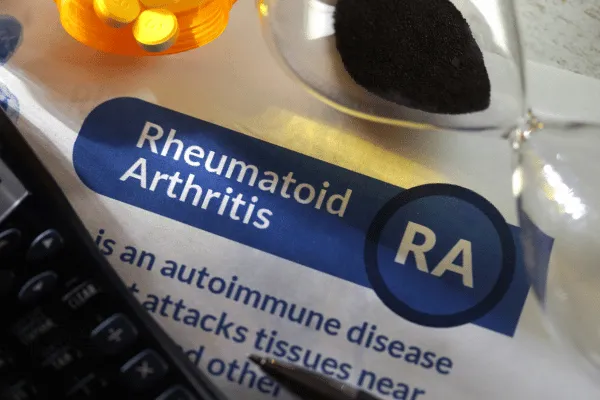About Arthritis
As the nation’s #1 cause of disability, arthritis affects nearly 60 million adults and 300,000 children. Over 100 types of arthritis and related conditions damage the joints and often other organs.
How can we assist you?
Helpful Tools for You

Scientific Breakthrough Unveils Promising New Path for Rheumatoid Arthritis Treatment
Groundbreaking research identifies genetic mutation that could lead to safer, more effective RA therapies
In an exciting development that could transform how we treat rheumatoid arthritis, researchers at York University have made a remarkable discovery that brings new hope to millions living with this challenging autoimmune condition. Their groundbreaking study, published in the Journal of Autoimmunity, has identified a specific genetic mutation that dramatically reduces inflammation—potentially paving the way for a revolutionary new class of targeted therapies.
The Game-Changing Discovery
Research led by York University's Faculty of Health reveals how a specific mutation in a protein called TRAF1 can shut down an overactive immune response, dramatically reducing inflammation in mice. Lead researcher Dr. Ali Abdul-Sater and his team used gene-editing technology to identify a critical mutation of a protein called TRAF1 and discovered that this mutation dramatically reduces inflammation by disrupting a critical molecular interaction that fuels the immune system into kicking into overdrive.
The discovery centers on a single, precise genetic change. A single mutation at position valine 196 (V196), the researchers found, selectively blocks TRAF1's interaction with another protein, which dampens a major inflammatory pathway triggered by receptors which are responsible for sensing infection and tissue damage. As Dr. Abdul-Sater explains, "The mutation effectively shuts down a cascade of molecular events that drive excessive inflammation."
Understanding TRAF1: The Key Player
"TRAF1 plays a central role in immune signaling and is known for its dual roles: it helps amplify inflammatory signaling in some contexts while also acting as a brake to limit overactive responses," says Dr. Abdul-Sater. "These opposing roles have made TRAF1 a challenging target for therapeutic intervention – until now."
This dual nature of TRAF1 has long puzzled researchers and made it difficult to target therapeutically. However, the York University team's discovery shows that it's possible to selectively disrupt specific TRAF1 interactions while preserving its beneficial regulatory functions—a precision approach that could lead to safer and more effective treatments.
Why This Matters for Current RA Treatment
Rheumatoid arthritis affects one per cent of the population worldwide. In the autoimmune disease, the body starts attacking its own cells, making the joints stiff, swollen and painful. Over time, this can damage joints, cartilage and bone, making everyday tasks difficult. The current treatment landscape, while improved over recent decades, still presents significant challenges for many patients.
Typical treatments involve broad immunosuppressants, like steroids, or biologics that inhibit specific cytokines, but these can lose effectiveness over time and can put individuals at greater risk for cancer, infections and other risks, notes Dr. Abdul-Sater. This limitation affects many individuals in our community who struggle with medication tolerance, effectiveness, or accessibility issues.
Current Treatment Challenges:
Broad Immunosuppression Risks: Current treatments for rheumatoid arthritis include broad immunosuppressants, such as steroids, and biologics that inhibit specific cytokines. However, these treatments often lose effectiveness over time and can increase the risk of cancer, infections, and other adverse effects.
Limited Treatment Response: Many patients don't respond adequately to current first-line treatments, requiring multiple medication trials to find effective management strategies.
Access and Cost Barriers: Biologic medications, while effective for many, come with significant cost considerations and complex administration requirements.
The Promise of Precision Medicine
The discovery of the TRAF1 mutation offers a more targeted approach, potentially reducing these risks while offering a long-lasting therapeutic effect. This represents a significant shift toward precision medicine in rheumatoid arthritis treatment—moving from broad-spectrum immune suppression to targeted intervention at the molecular level.
"Such therapies could not only alleviate symptoms but also address the underlying mechanisms of inflammation, benefiting patients who do not respond to existing options," Dr. Abdul-Sater adds. The findings could lead to the development of a new class of drugs that not only manage symptoms but also address the root cause of inflammation.
Research Findings: From Laboratory to Hope
The research team's findings extend beyond rheumatoid arthritis, demonstrating broad anti-inflammatory effects. Remarkably, mice harboring the TRAF1 V196A mutation are protected from LPS-induced septic shock and exhibit markedly reduced joint inflammation and disease severity in the CAIA model of RA. This suggests that therapies based on this discovery could potentially benefit other inflammatory conditions as well.
The molecular mechanism underlying this protective effect is becoming clearer. We demonstrate that TRAF1 is recruited to the TLR4 complex and is indispensable for the recruitment of cIAP2, facilitating TAK1 phosphorylation and the activation of NF-κB and MAPK signaling pathways. By disrupting this specific interaction, researchers can effectively "turn down" inflammation without completely shutting down the immune system.
What This Means for the RA Community
For the millions of Americans living with rheumatoid arthritis, this discovery represents several potential advantages:
Improved Safety Profile
By targeting a specific molecular interaction rather than broadly suppressing the immune system, future therapies based on this research could reduce the risk of infections and other serious side effects associated with current treatments.
Enhanced Effectiveness
"Rheumatoid arthritis is a common health condition which can interfere with many aspects of daily life and based on the limited efficacy of current treatments, novel approaches are needed," says Dr. Abdul-Sater. This targeted approach could offer new hope for individuals who haven't found adequate relief with existing therapies.
Addressing Root Causes
Unlike treatments that primarily manage symptoms, therapies based on this discovery could target the fundamental inflammatory processes driving RA, potentially offering more comprehensive disease control.
The Road Ahead: From Discovery to Treatment
While this research represents a significant breakthrough, it's important to understand that translating laboratory discoveries into available treatments takes time. The research team has identified the mechanism and demonstrated its effectiveness in laboratory models, but several steps remain before this becomes a clinical reality:
Further Research: Additional studies will refine our understanding of how to safely and effectively target this pathway in humans.
Drug Development: Pharmaceutical companies will need to develop compounds that can replicate the beneficial effects of this genetic mutation.
Clinical Trials: Rigorous testing in human volunteers will be necessary to ensure safety and effectiveness.
Regulatory Approval: Any new treatments will require approval from health authorities before becoming available to patients.
A New Chapter in RA Research
"In this study, we have made a discovery that may pave the way for more effective treatments for rheumatoid arthritis and other inflammatory diseases," says Dr. Abdul-Sater. This discovery represents more than just another research milestone—it embodies a new approach to understanding and treating rheumatoid arthritis.
The research demonstrates that precision medicine approaches, which target specific molecular pathways rather than broadly suppressing immune function, hold tremendous promise for improving outcomes while reducing treatment-related risks. For our community, this means hope for more effective, safer, and more accessible treatments in the future.
Staying Informed and Involved
While we await the translation of this research into clinical treatments, there are ways our community can stay engaged:
Stay informed about ongoing research developments and clinical trial opportunities
Participate in research when appropriate, as studies like this depend on community involvement
Advocate for research funding that supports innovative approaches to RA treatment
Connect with research institutions that may be conducting related studies
Looking Forward with Hope
This breakthrough from York University joins a growing body of research that's revolutionizing our understanding of rheumatoid arthritis. From environmental factors that influence disease development to genetic discoveries that point toward new treatments, the scientific landscape for RA is rapidly evolving.
These findings reveal a previously unrecognized and crucial role for the TRAF1/cIAP2 axis in promoting inflammation and offer a promising foundation for the development of novel therapeutic strategies for inflammatory conditions, such as RA.
For those living with rheumatoid arthritis today, this research represents the promise of tomorrow—a future where treatments are more precise, more effective, and safer. While we continue to manage our condition with currently available therapies, discoveries like this remind us that the story of rheumatoid arthritis treatment is still being written, with new chapters of hope being added by dedicated researchers around the world.
At the American Arthritis Foundation, we celebrate research breakthroughs like this that bring hope and new possibilities to our community. We remain committed to keeping you informed about the latest developments in RA research and supporting your journey toward better health and improved quality of life.

Effects of Arthritis

Cause of Disability
In the United States, 23% of all adults, or more than 54 million people, have arthritis. It is a leading cause of work disability, with annual costs for medical care and lost earnings of $303.5 billion.

Workforce Effects
Sixty percent of US adults with arthritis are of working age (18 to 64 years). Arthritis can limit the type of work they are able to do or keep them from working at all.

Global Impact
In fact, 8 million working-age adults report that their ability to work is limited because of their arthritis. For example, they may have a hard time climbing stairs or walking from a parking deck to their workplace.
Promoting Interventions That Reduce Arthritis Pain
American Arthritis Foundation recognizes several proven approaches to reduce arthritis symptoms:
Be active. Physical activity—such as walking, bicycling, and swimming—decreases arthritis pain and improves function, mood, and quality of life. Adults with arthritis should move more and sit less throughout the day. Getting at least 150 minutes of moderate-intensity physical activity each week is recommended.
Protect your joints. People can help prevent osteoarthritis by avoiding activities that are more likely to cause joint injuries.
Talk with a doctor. Recommendations from health care providers can motivate people to be physically active and join a self-management education program. Should your arthritis be interfering with your activities of daily living you may be a candidate to receive many new treatments, and learn how to reverse the arthritis condition.
Have a question?
We're Here to Help
By providing my phone number, I agree to receive text messages from the business.


